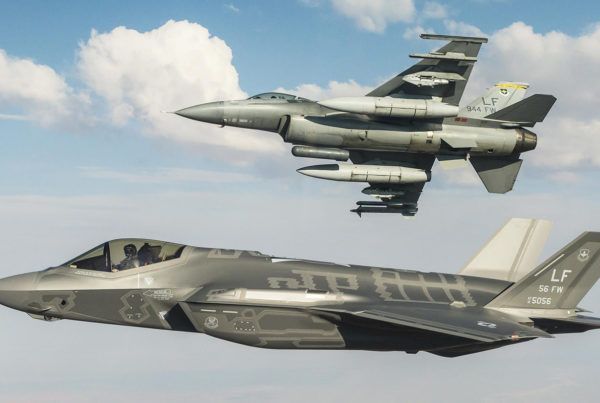 Local, State Leaders Work Together to Make Arizona A National Model for Protecting Military Bases
Local, State Leaders Work Together to Make Arizona A National Model for Protecting Military Bases
West Valley and state leaders have been working together to take proactive steps in preserving and enhancing the long-term mission viability of the state’s military installations.
Their actions may soon pay off as Luke Air Force Base is one of several Air Force bases being considered for the upcoming F-35 training mission.
Since the first successful state legislation was passed in 1978, there has been a coordinated and continuous approach to establishing compatible land uses around military bases in Arizona, including Luke.
State laws establish compatible land uses and other protections within noise contours and accident potential zones that ensure that responsible land-use planning and development occurs around Luke.
The state legislation reflects the tremendous commitment local, regional and state leaders have in protecting military installations statewide from development encroachment, according to Arizona Attorney General Terry Goddard, who recently traveled to Washington to brief top Air Force officials on Arizona’s strong support for Luke’s mission.
“Luke is a critical economic asset and a point of pride for all Arizonans. I am committed to leading the fight to enforce state laws protecting the base from encroachment and will continue to work with state, local and federal officials to secure the F-35 training mission at Luke.”
The Arizona Legislature has taken a variety of proactive steps in to protect Luke and other military airports in the state, including the establishment of:
- Enhanced notification requirements of proposed development in the vicinity of military airports.
- Increased disclosure on the sale of land within the vicinity of military airports.
- A chart of compatible land uses within high noise and accident potential zones.
- Sound attenuation standards for development near military airports.
- Statutes prohibiting natural gas storage facilities within nine miles of military airports.
- Zoning protections around auxiliary fields to mirror those around primary military airports.
- A “Military Installation Fund” used to buy land near bases or finance infrastructure improvements.
- Notification to potential homebuyers interested in purchasing homes that are under military training routes of military activity overhead.
When state legislation led to the establishment of noise contour lines around Luke, state and local leaders had the foresight to make the area within the noise lines larger in order to provide the flexibility to accommodate new aircraft and changing training missions.
For example, the current noise contour lines are almost twice as large that what is necessary for Luke’s current F-16 training mission.
In addition to the state statutes already in place, West Valley cities surrounding Luke have protected 32,788 acres from development that would be incompatible with Luke’s training mission.
“Goodyear is proud to be known as ‘The Protector of Luke’s Southern Departure Corridor,'” said Goodyear Mayor Jim Cavanaugh. “More than 90 percent of the high noise contour areas around the corridor are in Goodyear and properly zoned now to protect Luke’s mission. We also spent $3.5 million — 10 percent of the city’s operating budget — to buy Duncan Family Farms in 2003 and make sure the departure corridor remains indisputably clear.”
Today, Arizona is recognized as a national model in protecting military facilities. But, in order for this success story to continue, both the public and private sectors must continue to be aggressive in supporting efforts to protect and continue the mission at Luke, Cavanaugh said.








